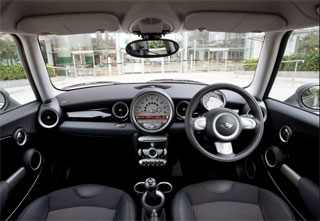
[Technologizer. Read Original]
Recently, I drove a Mini Cooper for the first time. (Rented from Zipcar for $13/hour. Not bad.)
That’s not news, obviously. They’ve been around forever. But it taught me something very important about product design: It’s really hard–and aggravating–for us consumers if you mess with our way of doing things.
For example, it took me several minutes to figure out how to put the window up. Nothing on the door, where I would first expect it. Nothing on the center console, my second choice. Finally, I found a barely labeled button near the radio controls. I had similar trouble trying to put the seat back to get luggage in the rear of the car. The levers weren’t where they are in every other car I’ve driven.
Am I dumb? Maybe, but not in this case. We have longstanding ways of doing things that have evolved for good reasons. Now, finding the buttons on a Mini Cooper isn’t such a big deal. You do it once, and then you know. But what if someone tries to change the entire way you watch TV?
Take 3D, for example. I like to sit back–heck, lay back–on the couch. That won’t work with 3D. With some sets, you can’t even tilt your head a few degrees to the side, or you lose the effect. So much for leaning against the arm of the couch, or on your sweetie’s shoulder.
The biggest problem, however, is that no one asked for 3D TV. I like my couch potatoing just fine, thank you. The industry simply told us that we should want it so they can sell more stuff. Selling stuff is fine, but you’ll do better if you sell what people want.
Companies were thinking that 3D would be the same as HDTV, but it’s not. Everyone wanted HD, for some reason.
We’ve been seeing, essentially, HD in the movies for decades (film has much more detail than old-fashioned TV). We’ve also been seeing flat sci-fi screens going back to the silent-movie era. Better picture, less clutter, sexier design, bigger screen? Yep, we want that.
Similar to the 3D debacle is the recently launched Google TV. How many years will it take (about ten, so far) for tech companies to realize that we don’t want a keyboard in our laps when we are vegging.
Or if we do, we’ll grab our laptops or smartphones–not to control the TV, but to do laptoppy things like look stuff up (on Google!), email, Facebook post, or Tweet. (The chatter that some shows, Like Glee, get on Twitter is amazing.)
A search bar for TV shows, movies and other videos? OK, that’s great. But seven screens of complex features–that’s baffling. (This is terribly ironic, coming from a company famous for its minimalist white home screen.)
Google’s idea may in fact be a better way to watch TV (though I doubt it).
But it’s too foreign for people who’ve spent decades watching another way. A mistake that Google makes, repeatedly, is thinking that consumers will automatically see the light of innovation that Google shines on them.
So what can tech companies do better? Listen, watch and learn. See what we love, and don’t mess with it. See what we hate, and try really hard to offer something better–not something merely different but equally unappealing.
(Seán Captain is a consumer strategist focusing on media, technology and entertainment for consumer trends firm Iconoculture.)
